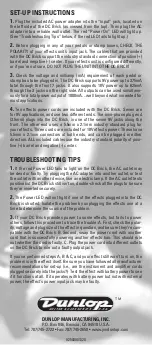
DUNLOP MANUFACTURING, INC.
P.O. Box 846, Benicia, CA 94510 U.S.A.
Tel: 707/745-2722 • Fax: 707/745-2658 • www.jimdunlop.com
92503001320
SET-UP INSTRUCTIONS
1.
Plug the included AC power adapter into the “Input” jack, located on
the left side of the DC Brick (as viewed from the top). Then plug the AC
adapter into a reliable wall outlet. The red “Power On” LED will light up.
(See “Troubleshooting Tips” below, if the red LED fails to light up.)
2.
Before plugging in any of your pedals or stomp boxes, CHECK THE
POLARITY of your effects unit’s input jack. The cables that are provided
with the DC Brick support the industry standard connection of positive (+)
barrel and negative (-) center. If your effects unit is configured differently,
or if you’re not sure, DO NOT PLUG THE UNIT INTO THE DC BRICK!
3.
Check the voltage and milliamp (mA) requirement of each pedal or
stomp box to be plugged in. The DC Brick supports 9V power up to 375mA
total through the front 7 jacks. It also supports 18V power up to 625mA
through the 3 jacks on the right side. All outputs can be used simultane-
ously for a total power output of 1000mA…well beyond what is needed for
most applications.
4.
Ten effects power cords are included with the DC Brick. Seven are
for 9V applications, and use two different ends. The mini-phone plug end
(3.5mm) plugs into the DC Brick, in one of the seven 9V jacks along the
front. The other end uses a 5.5mm x 2.1mm industry standard plug for
your effects. Three cords are included for 18V effects power. These have
5.5mm x 2.1mm connectors at both ends, and can be plugged in either
direction. ALL included cables use the industry standard polarity of posi-
tive (+) barrel and negative (-) center.
TROUBLESHOOTING TIPS
1.
If the red Power LED fails to light on the DC Brick, the AC outlet may
be dead or faulty. Try plugging the AC adapter into another outlet, or test
the outlet with another device, like an electric lamp. If the AC outlet tests
positive but the DC Brick still isn’t on, double-check all the plugs to be sure
they’re inserted securely.
2.
The Power LED will not light if one of the effects plugged into the DC
Brick is shorted. Isolate the problem by unplugging the effects one at a
time to determine the source of the problem.
3.
If your DC Brick provides power to some effects, but fails to power
others, follow this procedure to trace the trouble: A. First, check the polar-
ity, voltage and plug size of the effect in question, and be sure they’re com-
patible with the DC Brick. B. Second, swap the power cord with another
cord that is successfully powering another effects box. This should rule
out whether the cord is faulty. C. Plug the power cord into different outlets
on the DC Brick to rule out a faulty output jack.
If you’ve performed steps A, B & C, and your effect still won’t turn on, the
problem is in the effect itself. Be sure you have followed all manufacturer
recommendations for set-up (i.e., are the instrument and amplifier cords
plugged securely into the jacks?) Test the effect with battery power to see
if it functions at all. If it operates with battery power but not with external
power, the effect’s power input jack may be faulty.
G U I T A R A C C E S S O R I E S U.S.A.
TM




















